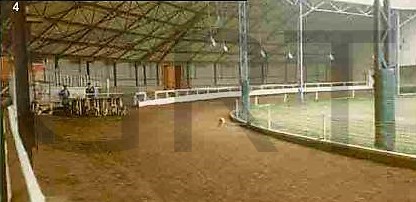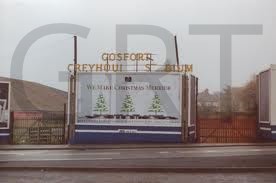Great North Road, Gosforth, Newcastle-upon-Tyne, Tyneside.
POSTCODE———————————-NE3 5BU
LOCATED————————————About three miles north of Newcastle city centre just off the B1318 Great North Road, about half a mile north of Gosforth town centre.
ORIGINAL SITE—————————–Originally constructed as an Athletics stadium during the 1890’s.
DATE CONSTRUCTED——————–1890’s.
DATE VENUE OPENED——————-1890’s for Athletics then Rugby Union.
Meaning other sports may have taken place prior to the arrival of Greyhound Racing.
FIRST MEETING—————————-May 21st 1932.
Greyhound Racing only.
LICENSED OR INDEPENDENT———-Mainly NGRC but switched to an Independent track for the last 18 months or so of its existence.
All venues covered would have to be licensed with the government, licensed suggested in this section would refer to tracks operating under NGRC Rules.
INSIDE OR OUTSIDE HARE TYPE——Inside Sumner.
Please note that the Electric Hare suggested is only a guidance and would have been in operation for a certain amount of time at this venue. Although it is not necessarily guaranteed that it was operational all the time, as other types of lure may have been used and updated as time progressed.
DISTANCES———————————–277, 480, 614, 680 and 864 metres.
Please note that most racing venues distances had become varied throughout the years, the ones given above were at once point set and offers only a guidance to the track size.
CIRCUMFERENCE—————————About 400 metres.
Please note that alterations at most racing venues throughout its existence would see that the circumference of the track would vary, the one shown above offers only a guidance to the track size.
BIG RACE NAMES—————————Nothing known of.
STADIUM SHARED WITH——————Athletics, Cycling, Rugby Union and Speedway.
LAST MEETING——————————-July 29th 1987.
Greyhound Racing only.
STADIUM CLOSURE DATE—————-August 1987.
Meaning other sports may have taken place after Greyhound Racing had ceased.
STADIUM DEMOLITION——————–1988.
BUILT ON SITE——————————–An ASDA Superstore.
In some cases, structure’s that originally covered the venue after the stadium had been demolished, may have been themselves demolished too, so the one described is more likely to be the one which now presently covers the site.
EVIDENCE LEFT TODAY——————–Nothing known of.
FURTHER COMMENTS———————Gosforth was the sister track to Gateshead. The venue had a period of races being staged on peat surface, an experiment that would have hoped to reduce injuries, and also reduce the risk of the track freezing in winter.















During the early 1890’s an athletics track began to develop along side the Great North Trunk Road, on the outskirts of Gosforth, three miles north of Newcastle City Centre. The track had been nothing more than a cinder track on a sports field, but as a rugby union club made it their home, spectator viewing stands were added.
The County Rugby Ground Gosforth, as it was known, became the home of Gosforth Nomads and also the headquarters for Northumberland Rugby Union. By the turn of the 20th century, a cycle track was added around the perimeter of the pitch, which later became covered by a cinder track during 1929, the reason being to accommodate the new up and coming sport of Speedway Racing. Yet speedway did not live up to its expectations, and disappointingly lasted for no more than two seasons, which gave an opportunity for Greyhound Racing to feature at Gosforth Park. The foundations of the speedway track made it easy to lay the new greyhound track, and soon Gosforth was up and running with its inaugural meeting coming on the 21st of May 1932.
Greyhound racing operated under NGRC rules, and by 1937 had built up a relationship with a new sister track south of Newcastle at Redheugh Park, Gateshead. By the outbreak of the Second World War, the stadium had developed into something of a unique arena, with the track being totally covered all the way round with a cantilevered roof, to help protect the greyhound track from adverse weather. The increase in size had seen its crowd capacity swell to around 18,000, and had much similarities to other tracks such as the old Crayford track, and also the design of the White City stadium’s that operated around the Country. Gosforth also experimented with different types of running surfaces, eventually switching from grass to that of a peat type surface, claiming that the new surface could reduce injuries, it would be cheaper to maintain and also more resilient towards the winter weather.
In 1976 the bookmakers Ladbrokes, who also owned the Crayford track in London, took over the lease even though the stadium was still owned by Northumberland Rugby Club. Due to the narrowness of the track, it featured mainly five dog racing, and ran events over distances of 277, 480, 614, 680 and 864 metres. The track had a circumference of around 400 metres, with the greyhounds contesting behind an inside Sumner type hare. Turbulent times arrived in 1980, when Ladbrokes tried to close the stadium due to continuous losses, but a long term agreement held with the rugby club saved the track from the inevitable closure.
In the summer of 1985, after 53 years of racing under NGRC rules, Gosforth signed up for a BAGS meeting contract, with permit licenses being offered to local trainers. Yet within the first three months concerns were growing, as the local press were printing reports regarding the welfare of the track owned greyhounds. It had claimed that Gosforth was struggling to fulfil the programmes requirements, as it becoming clear that some greyhounds were being forced to race as many as four times in a week. There was evidence of injured dogs being entered, and also a race being run with all six dogs being entered by the same trainer, with a winning time given as three seconds slower than normal.
In October 1985 pressure from the NGRC forced Gosforth to quit the BAGS meetings, and by the following month its only way of survival was to switch to independent racing. The switch became no answer to Gosforth’s declining attendances, with the track now running at a financial loss, it was clear that its future remained bleak, and came as no surprise when the stadium was sold for development in 1987.
Its final meeting came on the 29th of July 1987, the doors closing leaving the stadium to decay until its demolition the following year. No evidence remains of the stadium today, as it has now totally gone, the site is covered by an ASDA superstore positioned along the side the busy B1318 Great North Road.
Memorabilia for this track is required for this page, if you can help please contact me.

Recent Comments